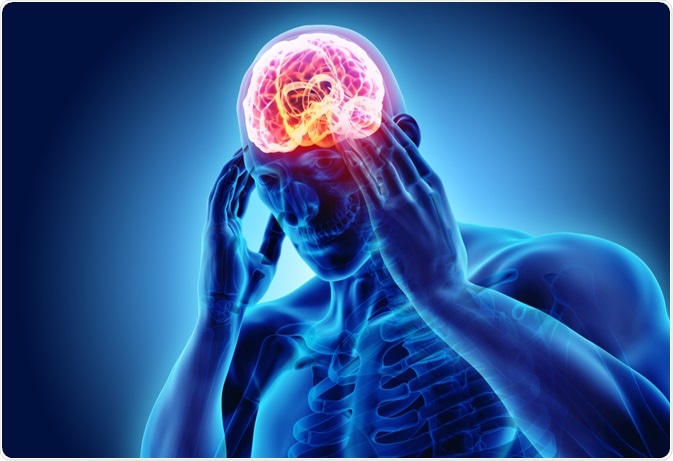Migraines are a complex type of recurring headaches that cause throbbing pain, usually to one side of the head.

Image Credit: MDGRPHCS/Shutterstock.com
They are one of the most common types of headaches that are referred to as neurologists. These headaches may tend to be associated with signs and symptoms such as nausea, vomiting, photophobia, and phonophobia.
While studies suggest that there is a genetic component to migraine headaches, there are several triggering factors, which include stress, hormonal fluctuations, anxiety, overexertion, sleep disturbance, sudden changes in weather and strong smells, among many others. Not surprisingly, several foods are reportedly associated with the triggering of this syndromic disorder.
Traditionally, alcohol, chocolate, aged cheese and monosodium glutamate (MSG) were food culprits for the triggering of migraine headaches in many patients. However, newer evidence shows that these triggers may not be as absolute as previously believed.
Foods are generally considered to be triggers if there is documented direct and strict proportionality between consumption of the food and the initiation of the migraine. This direct proportionality must be regular to ascertain a correlation between the trigger and the headache.
Alcohol
While some may consider alcohol an overstated migraine risk, it is known to trigger attacks either within a few hours of consuming alcoholic beverages or because of a hangover.
The proportionality of the alcohol-migraine relationship has been investigated by many studies, but the jury is still out as to whether these studies provide compelling evidence of causality. Nonetheless, it is still recommended that alcohol consumption is kept to an absolute minimum, or completely avoided, if possible, in those whose migraines are triggered by its use.
Chocolate
Although the scientific evidence is ambiguous at best, chocolate is widely reported as a migraine trigger. Epidemiological studies suggest a chocolate-migraine relationship. However, the strength of this relationship is weak at best, with studies showing that anxiety, stress and sleep disturbance are much more likely to cause migraines than chocolate. As is the case with all triggers, which may vary from person to person, patients who experience attacks after chocolate consumption should take the necessary precautions.
Aged cheese
Cheddar, blue cheese, Mozzarella, Parmesan, Feta, Swiss, and Gouda, have all been implicated as migraine-attack triggers. While there is a paucity of research with regards to the aged-cheese-migraine relationship, it is believed that tyramine, which is a substance present in these cheeses, may be the culprit.
The amount of tyramine in the cheese is directly proportional to the age of the cheese, and those affected are advised to exercise caution.
Monosodium glutamate
MSG is one of the best-known food additives linked to migraine attacks. As is the case with the food offenders, there is no concrete scientific evidence to prove or disprove the MSG-migraine relationship. Likewise, patients with MSG-reported migraine sensitivity should avoid foods containing this compound.
Other migraine-linked foods
In addition to the above, other allegedly migraine-causing foods include yeast, cured or processed meats, as well as some nuts and fruits.
Sulfite preservatives found in dried fruits are believed to be linked to the triggering of migraines. Likewise, citrus fruits, navy beans, lima beans, and onions have also been implicated in some persons. It is believed that compounds present in these foods cause the release of histamine, which may then trigger a headache. However, there is no scientific evidence to support the foods claimed to elicit migraines.
Because headache triggers can vary from person to person, patients with migraines are advised to keep a food and headache diary so they can try to determine which foods may be associated with headaches for them.